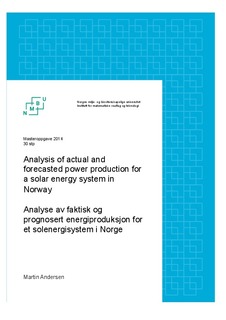| dc.contributor.author | Andersen, Martin | |
| dc.date.accessioned | 2014-09-24T10:08:35Z | |
| dc.date.available | 2014-09-24T10:08:35Z | |
| dc.date.copyright | 2014 | |
| dc.date.issued | 2014-09-24 | |
| dc.identifier.uri | http://hdl.handle.net/11250/221415 | |
| dc.description | Analysis of the forecasting accuracy of the simulation tool PVsyst for a solar energy system in Norway.
Critical evaluation of meteorological sources and suitability for use in forecasting.
Economical consequences of forecasting inaccuracy.
Suggested measures to minimize discrepancy. | nb_NO |
| dc.description.abstract | In this thesis, the uncertainty related to the forecasting of yield for a solar energy system in Norway has been evaluated. The system was a 2 kWp PV-system located on the campus of the Norwegian University of Life Sciences (NULS).
The work conducted aimed at determining the existing discrepancy between forecasted and actual yield for the PV-system, comparing forecasts of annual yield, generated by the simulation software PVsyst, to inverter output data for one year.
Moreover, it investigated the different factors influencing this discrepancy, by evaluating forecasted system losses and their relation to the meteorological data used as input.
The effect of the diffuse-to-global ratio (DGR) in datasets has been investigated, along with the consequences induced in the simulation program used.
Also, the effect of missing diffuse data has been tied to high errors in forecasting, especially for months of low irradiance levels.
The economic consequences of the discrepancies between actual and forecasted yield have been evaluated by calculating the levelized cost of energy (LCOE) for the forecasted yield and comparing this to the actual LCOE.
The effect of soiling has been discussed and suggestions have been made as to appropriate soiling values for solar energy systems within a climatic distance of 20 km from the PV-system evaluated.
The results showed a mean bias error (MBE) of -8.1% and RMSE of 10.3% in an ideal scenario with only 2% degradation losses applied, when disregarding choice of source for meteorological data.
The most accurate forecasts of annual yield had a bias error (BE) of -0.2%, using meteorological data from the NASA SSE database.
The worst performing forecast in this scenario had a BE of -19.7%, using data from the PVGIS database.
Measured data from weather stations in the vicinity of the PV-system site, on best yielded a BE of -2.3%.
In a heavy soiling scenario, an MBE of -25.3% and RMSE of 26.5% were obtained when disregarding the choice of meteorological data source.
The best performing forecast had a BE of -20.2% and was obtained using meteorological data from the NASA SSE database.
The worst performing forecast in this scenario had a BE of -34.3%, using data from the PVGIS database.
Measured data from weather stations in the vicinity of the PV-system site at best yielded a BE of -23.6% in this scenario.
Of all the sources for meteorological data, the NASA SSE database showed to yield the most accurate forecasts and consistently proved to forecast accurately within an assumed investor risk tolerance of 6 - 7% when excluding heavy soiling. | nb_NO |
| dc.description.sponsorship | Institute for Energy Technology (IFE) | nb_NO |
| dc.language.iso | eng | nb_NO |
| dc.publisher | Norwegian University of Life Sciences, Ås | |
| dc.rights | CC0 1.0 Universal | * |
| dc.rights.uri | http://creativecommons.org/publicdomain/zero/1.0/ | * |
| dc.title | Analysis of actual and forecasted power production for a solar energy system in Norway | nb_NO |
| dc.title.alternative | Analyse av faktisk og prognosert energiproduksjon for et solenergisystem i Norge | nb_NO |
| dc.type | Master thesis | nb_NO |
| dc.subject.nsi | VDP::Technology: 500::Electrotechnical disciplines: 540::Electrical power engineering: 542 | nb_NO |
| dc.subject.nsi | VDP::Mathematics and natural science: 400::Geosciences: 450::Meteorology: 453 | nb_NO |
| dc.source.pagenumber | 199 | nb_NO |
| dc.description.localcode | M-MF | nb_NO |

